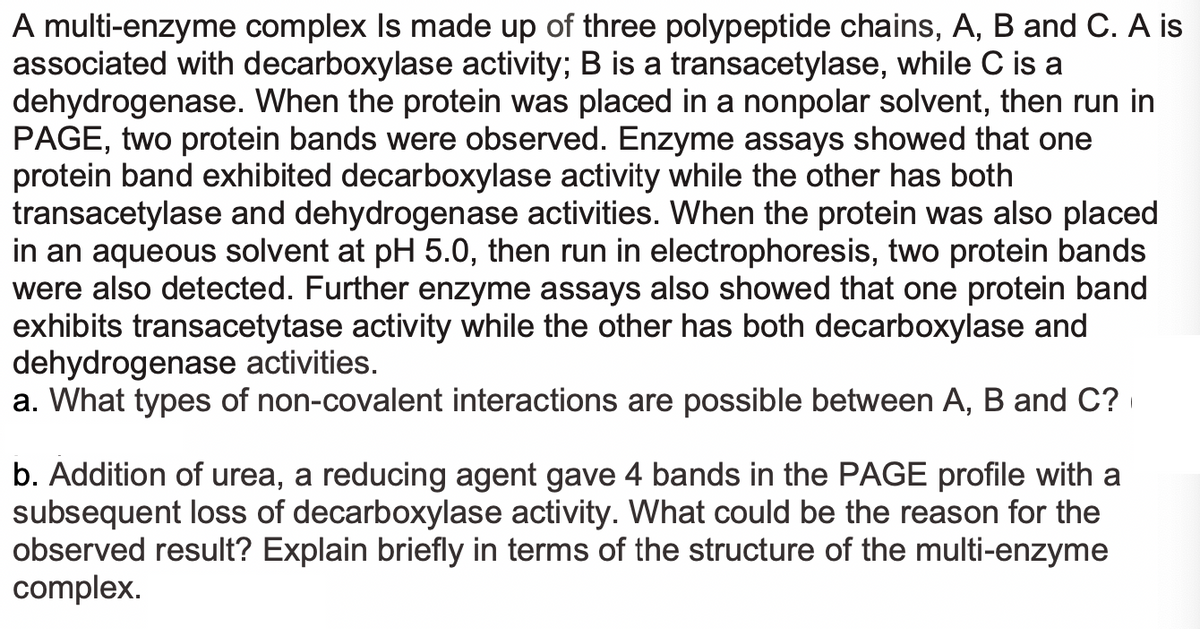A multi-enzyme complex Is made up of three polypeptide chains, A, B and C. A is associated with decarboxylase activity; B is a transacetylase, while C is a dehydrogenase. When the protein was placed in a nonpolar solvent, then run in PAGE, two protein bands were observed. Enzyme assays showed that one protein band exhibited decarboxylase activity while the other has both transacetylase and dehydrogenase activities. When the protein was also placed in an aqueous solvent at pH 5.0, then run in electrophoresis, two protein bands were also detected. Further enzyme assays also showed that one protein band exhibits transacetytase activity while the other has both decarboxylase and dehydrogenase activities. a. What types of non-covalent interactions are possible between A, B and C? b. Addition of urea, a reducing agent gave 4 bands in the PAGE profile with a subsequent loss of decarboxylase activity. What could be the reason for the observed result? Explain briefly in terms of the structure of the multi-enzyme complex.
A multi-enzyme complex Is made up of three polypeptide chains, A, B and C. A is associated with decarboxylase activity; B is a transacetylase, while C is a dehydrogenase. When the protein was placed in a nonpolar solvent, then run in PAGE, two protein bands were observed. Enzyme assays showed that one protein band exhibited decarboxylase activity while the other has both transacetylase and dehydrogenase activities. When the protein was also placed in an aqueous solvent at pH 5.0, then run in electrophoresis, two protein bands were also detected. Further enzyme assays also showed that one protein band exhibits transacetytase activity while the other has both decarboxylase and dehydrogenase activities. a. What types of non-covalent interactions are possible between A, B and C? b. Addition of urea, a reducing agent gave 4 bands in the PAGE profile with a subsequent loss of decarboxylase activity. What could be the reason for the observed result? Explain briefly in terms of the structure of the multi-enzyme complex.
Biology: The Dynamic Science (MindTap Course List)
4th Edition
ISBN:9781305389892
Author:Peter J. Russell, Paul E. Hertz, Beverly McMillan
Publisher:Peter J. Russell, Paul E. Hertz, Beverly McMillan
Chapter4: Cells
Section: Chapter Questions
Problem 1ITD
Related questions
Question

Transcribed Image Text:A multi-enzyme complex Is made up of three polypeptide chains, A, B and C. A is
associated with decarboxylase activity; B is a transacetylase, while C is a
dehydrogenase. When the protein was placed in a nonpolar solvent, then run in
PAGE, two protein bands were observed. Enzyme assays showed that one
protein band exhibited decarboxylase activity while the other has both
transacetylase and dehydrogenase activities. When the protein was also placed
in an aqueous solvent at pH 5.0, then run in electrophoresis, two protein bands
were also detected. Further enzyme assays also showed that one protein band
exhibits transacetytase activity while the other has both decarboxylase and
dehydrogenase activities.
a. What types of non-covalent interactions are possible between A, B and C?
b. Addition of urea, a reducing agent gave 4 bands in the PAGE profile with a
subsequent loss of decarboxylase activity. What could be the reason for the
observed result? Explain briefly in terms of the structure of the multi-enzyme
complex.
Expert Solution
This question has been solved!
Explore an expertly crafted, step-by-step solution for a thorough understanding of key concepts.
Step by step
Solved in 3 steps

Recommended textbooks for you

Biology: The Dynamic Science (MindTap Course List)
Biology
ISBN:
9781305389892
Author:
Peter J. Russell, Paul E. Hertz, Beverly McMillan
Publisher:
Cengage Learning

Biology: The Dynamic Science (MindTap Course List)
Biology
ISBN:
9781305389892
Author:
Peter J. Russell, Paul E. Hertz, Beverly McMillan
Publisher:
Cengage Learning